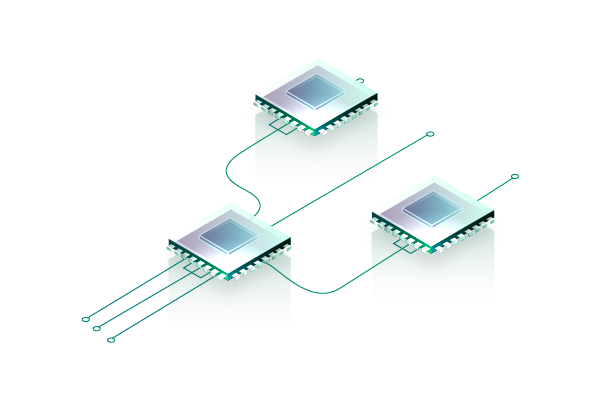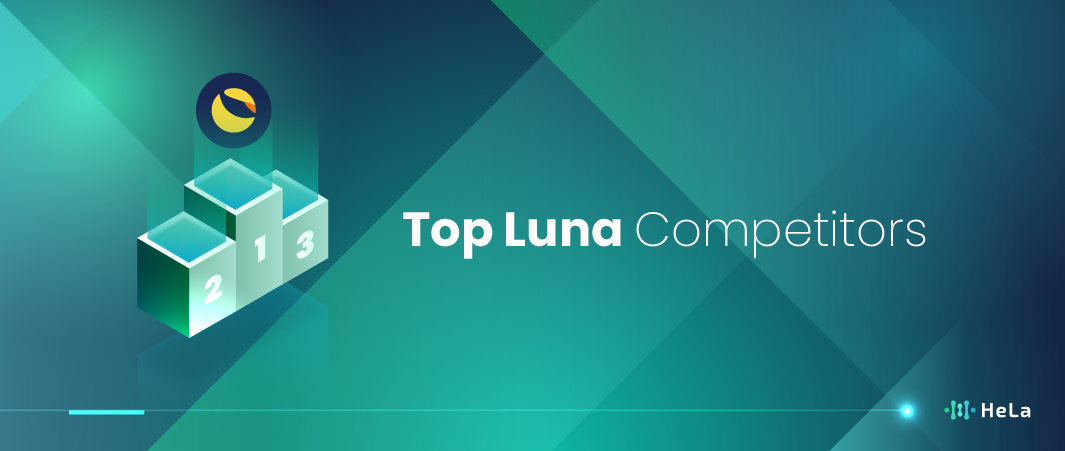In the ever-evolving realm of blockchain and digital currency, Terra (Luna) has emerged as a prominent player by 2024. This platform, known for its unique approach to stablecoins and decentralized finance (DeFi), has carved a niche in a landscape teeming with innovation. The world of cryptocurrencies is marked by rapid developments and a constant push for technological advancements, making Terra (Luna) a significant contributor to this dynamic field.
The blockchain industry, inherently dynamic, thrives on competition and the continuous introduction of novel ideas. In this context, exploring competitors and alternatives to Terra (Luna) becomes crucial. It’s not just about understanding the existing landscape but also about anticipating future trends. As new platforms emerge, they bring fresh concepts and approaches, thereby challenging existing paradigms and offering diverse opportunities for users and investors alike.
Recognizing the importance of this ever-changing ecosystem, this article aims to serve as a comprehensive guide to the top competitors and alternatives to Terra (Luna) as of 2024. This exploration is designed to cater to a broad audience, ranging from industry experts who seek to stay abreast of the latest developments, to newcomers who are navigating this complex yet fascinating world for the first time. Our goal is to provide insights that are both informative and accessible, offering a clear view of the landscape as it stands and the potential directions it may take in the future.
The Evolution of Blockchain Technology in 2024

As of 2024, blockchain technology has continued to evolve in various exciting ways, impacting various platforms, including Terra (Luna) and its competitors. Here are some of the key advancements and their implications:
- Increased Scalability and Speed: One of the most significant advancements in blockchain technology has been the improvement in scalability and transaction speed. This has been achieved through various means, such as sharding, layer-2 solutions, and more efficient consensus mechanisms. For platforms like Terra (Luna), this means the ability to process transactions more quickly and efficiently, attracting more users and developers.
- Enhanced Security Measures: Security has always been a paramount concern in the blockchain space. Recent advancements have seen the development of more sophisticated cryptographic techniques, including quantum-resistant algorithms, which have made blockchain networks more secure against various types of attacks. This enhances the trustworthiness of platforms like Terra (Luna), making them more appealing for financial applications.
- Cross-Chain Interoperability: The ability for different blockchain networks to communicate and share information has been a game-changer. This interoperability allows for a more interconnected ecosystem, enabling platforms like Terra (Luna) to seamlessly interact with other blockchains, expanding their use cases and user base.
Also Read: 7 Top of List Parallel EVM to Consider in 2024
- Decentralized Finance (DeFi) Innovations: The DeFi sector has continued to grow, with new protocols and financial instruments being developed. This includes everything from decentralized exchanges (DEXs) to yield farming and complex financial derivatives. For Terra (Luna) and its competitors, this opens up new avenues for integration and partnership, allowing them to offer more diverse services.
- Regulatory Developments: As blockchain technology matures, so does the regulatory landscape. There have been efforts to create more clear and supportive regulations, which help in legitimizing and stabilizing the market. This is beneficial for platforms like Terra (Luna) as it may lead to increased adoption by mainstream financial entities.
- Sustainability and Green Initiatives: There’s been a growing focus on making blockchain technology more environmentally sustainable. This includes the development of more energy-efficient consensus mechanisms like Proof of Stake (PoS). Terra (Luna) and other platforms that adopt these greener practices can appeal to a broader, more environmentally-conscious user base.
- Integration with Other Technologies: Blockchain is increasingly being integrated with other cutting-edge technologies like AI, IoT, and 5G. This convergence is leading to the creation of more sophisticated and multifunctional platforms, offering Terra (Luna) and its competitors new opportunities to innovate and expand their functionalities.
- NFT and Metaverse Expansion: The rise of NFTs and the metaverse has opened up new realms for blockchain applications. Platforms are exploring ways to incorporate NFTs for identity verification, ownership records, and more, while also finding their place in the evolving metaverse landscape.
- Community Governance Models: There’s a trend towards more decentralized governance models, where decisions are made by a community of stakeholders rather than a centralized authority. This democratic approach can lead to more user-centric development and greater transparency, benefiting platforms like Terra (Luna).
- Tokenomics Evolution: The design of token economies (tokenomics) is becoming more sophisticated, focusing on long-term sustainability and value creation. This benefits platforms like Terra (Luna) by creating more stable and attractive economic models for users and investors.
The advancements in blockchain technology in 2024 are multifaceted, ranging from technical improvements to regulatory and community developments. These changes have a profound impact on platforms like Terra (Luna) and their competitors, influencing their growth, user adoption, and the overall landscape of the blockchain industry.
7 Top Terra (Luna) Competitors & Alternatives in 2024

Terra (Luna) has gained significant traction in the blockchain and cryptocurrency space for its innovative approach to stablecoins and decentralized finance (DeFi). However, it’s essential to explore the landscape of its competitors and alternatives, each offering unique features, market positions, innovations, user bases, and points of contrast when compared to Terra (Luna). Let’s explore seven top Terra competitors and alternatives, each contributing unique features to the decentralized ecosystem.
1. HeLa Labs
HeLa Labs is leading the way in blockchain technology with its modular and scalable Layer-1 protocol, addressing critical issues such as interoperability and security. Compatible with the Ethereum Virtual Machine (EVM), the protocol ensures a smooth transition for Ethereum-based projects while enhancing security through its unique consensus mechanism. HeLa also focuses on decentralized digital identity management, empowering users with greater control over their personal information.
Furthermore, HeLa stands out by introducing a fiat-backed stablecoin to its ecosystem, bridging the gap between traditional finance and the blockchain world. This stablecoin provides stability and trust, fostering a conducive environment for both businesses and individuals to leverage blockchain technology for a wide range of financial applications. In summary, HeLa Labs combines modularity, security, digital identity management, and a stablecoin to advance blockchain technology and make it more accessible to a broader audience.
2. Polygon
Polygon is recognized for its innovative approach to scaling Ethereum through a multi-chain system. It provides a framework for building interconnected blockchain networks, offering solutions to common blockchain issues like high fees and slow speeds. Polygon’s strength lies in its high scalability and low transaction costs, making it attractive for developers and users alike. The platform’s decision to establish a fund for Terra developers underscores its commitment to fostering a vibrant developer ecosystem and expanding its network. This strategic move not only enhances Polygon’s technological capabilities but also positions it as a leader in the blockchain space.
3. Algorand
Algorand is a high-performance blockchain known for its speed, scalability, and security. It stands out in the blockchain space for its pure proof-of-stake (PPoS) consensus mechanism, which addresses the trilemma of security, scalability, and decentralization. Algorand’s focus on sustainable and efficient blockchain technology positions it as a carbon-negative network, appealing to environmentally conscious developers and users. The platform’s initiative to support Terra developers with incentives and an automated transition platform showcases its commitment to community development and technological innovation.
4. Injective
Injective Protocol distinguishes itself with its fully decentralized exchange protocol that allows for advanced trading across a range of financial products. The platform is designed to be highly scalable, fast, and secure, offering features like zero gas fees and instant transaction finality.
Injective’s unique selling point is its interoperability and support for cross-chain trading, which enables a seamless experience across different blockchain ecosystems. The platform’s support for Terra developers is indicative of its focus on community growth and collaborative development.
5. Kadena
Kadena offers a hybrid blockchain platform that combines the security of a public blockchain with the speed and scalability of a private network. Its unique proposition lies in its patented Chainweb technology, which simultaneously processes transactions on multiple chains, dramatically increasing network throughput and efficiency.
Kadena’s focus on creating a developer-friendly environment, evident in its $10 million fund for blockchain developers, showcases its commitment to innovation and community support. The platform’s approach aims to attract skilled developers to build advanced applications, solidifying its position in the blockchain space.
6. VeChain
VeChain stands out in the blockchain industry for its focus on enterprise use cases, particularly in supply chain management and business processes. It leverages blockchain technology to provide transparency, security, and traceability for various industries, including luxury goods, liquor, and agriculture.
VeChain’s strength lies in its practical applications, which demonstrate the real-world utility of blockchain technology. The platform’s offer of grants to Terra developers is a strategic move to expand its ecosystem and foster innovation.
7. Terra (LUNA) 2.0
Terra (LUNA) 2.0: Terra 2.0 represents a significant evolution from the original Terra (LUNA), designed as a response to the challenges faced by the original Terra network. This new iteration seeks to restore trust and stability in the Terra ecosystem.
Terra 2.0 maintains the use of a proof-of-stake (PoS) consensus mechanism and aims to provide a robust platform for decentralized applications (DApps) and financial services. It marks a fresh start for the network, focusing on creating a more sustainable and resilient infrastructure.
The success of Terra 2.0 depends on its ability to regain investor confidence and demonstrate stability in its operations. Its approach includes issuing new LUNA tokens to previous investors and focusing on building a strong community and developer support. This strategic move is crucial for Terra 2.0 to re-establish itself in the competitive blockchain space.
The Role of User Communities in Shaping Cryptocurrency Platforms
In exploring the role of user communities in shaping cryptocurrency platforms, it’s essential to understand how community engagement and feedback contribute to the growth and adaptation of these platforms. This can be examined through the lens of specific examples, such as Terra (Luna) and its competitors.
Terra (Luna)
- Community Governance: Terra’s ecosystem often relies on its community for decision-making. For example, proposals for upgrades or changes are frequently put to a vote, where token holders have a say.
- Feedback Mechanisms: Platforms like Terra incorporate user feedback into their development process. This can involve direct communication channels, forums, or social media interactions where users express their views.
- Adaptation to User Needs: Terra’s adjustments in response to community feedback, such as changes in staking rewards or transaction fees, demonstrate how user input can influence platform policies.
Competitors
- Different Approaches to Community Engagement: Other platforms might use different models of community engagement, like delegated governance, where certain members represent the broader community.
- Innovations Inspired by User Feedback: Competitors might introduce new features or services in response to observed needs within their communities, which can sometimes be a direct response to Terra’s offerings.
- Challenges and Responses: How competitors manage challenges, like security concerns or scalability issues, often reflects the demands and feedback of their user base.
Common Trends
- Decentralized Decision Making: A trend in many cryptocurrency platforms is the move towards decentralized governance, giving more power and voice to the community.
- Community-Driven Development: Platforms increasingly recognize the value of user-driven innovation, often leading to more user-friendly and efficient services.
- Challenges in Balancing Interests: Balancing the diverse interests of a global community is a common challenge, often leading to complex governance structures.
The role of user communities in shaping cryptocurrency platforms like Terra (Luna) and its competitors is pivotal. These communities not only provide valuable feedback but also participate in the governance and direction of the platforms. The dynamics of community engagement, the responsiveness of platforms to user feedback, and the adaptation of services and policies in accordance with user needs are key factors in the evolution and success of these cryptocurrency ecosystems.
Regulatory Challenges and Opportunities in the Crypto Space
Regulatory challenges and opportunities in the cryptocurrency space have evolved significantly by 2024. The regulatory environment for cryptocurrencies now involves a more sophisticated and comprehensive approach by various governments and international bodies.
- Stricter Compliance and Reporting Requirements: Cryptocurrencies, including platforms like Terra (Luna), are now subject to more stringent compliance standards. This includes the need for detailed reporting on transactions and adherence to anti-money laundering (AML) and know-your-customer (KYC) regulations.
- Framework for ICOs and Token Sales: There’s a clearer legal framework for initial coin offerings (ICOs) and token sales. This provides more security for investors but also imposes additional obligations on crypto companies.
- Taxation Policies: Cryptocurrencies are more consistently defined and taxed across different jurisdictions. This has implications for both individual investors and companies in the crypto space.
- Cross-Border Collaboration and Regulation: There’s an increased emphasis on cross-border regulatory cooperation. This is particularly important for cryptocurrencies like Terra (Luna), which operate on a global scale.
- Innovation-Friendly Regulations: Some jurisdictions have introduced regulations that are aimed at fostering innovation while ensuring investor protection. These regulations aim to balance the need for oversight with the potential of blockchain technology.
- Adaptation by Crypto Platforms: In response to these regulatory changes, platforms like Terra (Luna) have had to adapt. This includes establishing more robust legal and compliance departments, restructuring certain aspects of their operations to comply with regional laws, and engaging in proactive dialogue with regulators.
- Strategies by Competitors: Other crypto platforms are employing various strategies to navigate these challenges. These include diversifying their offerings to include more regulation-friendly products, engaging in self-regulation and standard-setting efforts, and seeking jurisdictions with more favorable regulatory environments.
- Emergence of Decentralized Finance (DeFi): DeFi has continued to grow, presenting new regulatory challenges. Regulators are grappling with how to oversee decentralized protocols, which don’t have a central authority.
- Consumer Protection Focus: There’s an increased emphasis on protecting consumers in the crypto market, which affects how platforms design their products and interact with users.
- Regulatory Sandbox Environments: Some countries have created ‘sandbox’ environments to allow crypto businesses to test new products and services in a controlled environment with regulatory oversight.
The Impact of Global Economic Trends on Cryptocurrencies

The global economic trends can significantly impact the performance and adoption of cryptocurrencies, including Terra (Luna) and its alternatives. Here’s an analysis of some key factors:
Inflation and Monetary Policy
Central banks’ monetary policies, especially in key economies like the US and EU, affect the value of fiat currencies. High inflation rates can lead to increased interest in cryptocurrencies as a hedge against devaluing fiat currencies. Conversely, tight monetary policies may strengthen fiat currencies, potentially reducing the appeal of cryptocurrencies.
Economic Stability and Investor Sentiment
Economic stability in major markets influences investor sentiment. During times of economic uncertainty or market crashes, investors might seek safe-haven assets. Traditionally, this has been gold or stable government bonds, but increasingly, cryptocurrencies like Bitcoin are considered. However, volatile assets like Terra (Luna) might be seen as risky in such times.
Regulatory Environment
The legal and regulatory stance of major economies on cryptocurrencies plays a crucial role. Positive regulation can lead to increased adoption and innovation, while restrictive policies might hinder growth or even lead to significant market downturns.
Technological Advancements
Developments in blockchain technology and increased utility of cryptocurrencies in everyday transactions influence their adoption. The more user-friendly and technologically advanced a cryptocurrency is, the more likely it is to be adopted.
Global Economic Integration
As the world economy becomes more interconnected, cryptocurrencies stand to benefit from increased cross-border transactions. Cryptocurrencies can offer a more efficient, less costly alternative to traditional banking systems, especially in countries with less stable currencies.
Also Read: 7 Top Cardano Competitors & Alternatives in 2024
Market Competition
The rise of alternatives to Terra (Luna), like stablecoins and other DeFi projects, can impact its market position. Competitive advancements or failures in these alternatives directly affect the performance and perception of Terra (Luna).
Public Perception and Media Coverage
The way cryptocurrencies are portrayed in the media and perceived by the public can significantly impact their adoption and value. Positive news and endorsements by influential figures can lead to increased interest and investment, while negative news can have the opposite effect.
Conclusion
The examination of Terra (Luna) and its competitors highlights a dynamic and diverse ecosystem within the blockchain and digital currency world. Understanding these platforms is crucial as they offer unique strengths and face distinct challenges, revealing the complexities and opportunities in this evolving space. Staying informed and adaptable is essential in this rapidly changing sector, which is ripe for innovation and growth, appealing to enthusiasts, investors, and developers alike.
Looking towards the future, the cryptocurrency landscape, including Terra (Luna) and its rivals, promises significant growth and influence. This emerging field is set to redefine financial transactions and play a crucial role in shaping the digital economy. With technological innovation and strategic creativity, the world of digital currencies is gearing up for transformative changes, offering exciting opportunities and a promising outlook for the industry.
Disclaimer: The information provided by HeLa Labs in this article is intended for general informational purposes and does not reflect the company’s opinion. It is not intended as investment advice or recommendations. Readers are strongly advised to conduct their own thorough research and consult with a qualified financial advisor before making any financial decisions.

Joshua Soriano
I am a writer specializing in decentralized systems, digital assets, and Web3 innovation. I develop research-driven explainers, case studies, and thought leadership that connect blockchain infrastructure, smart contract design, and tokenization models to real-world outcomes.
My work focuses on translating complex technical concepts into clear, actionable narratives for builders, businesses, and investors, highlighting transparency, security, and operational efficiency. Each piece blends primary-source research, protocol documentation, and practitioner insights to surface what matters for adoption and risk reduction, helping teams make informed decisions with precise, accessible content.
- Joshua Soriano#molongui-disabled-link
- Joshua Soriano#molongui-disabled-link
- Joshua Soriano#molongui-disabled-link
- Joshua Soriano#molongui-disabled-link

